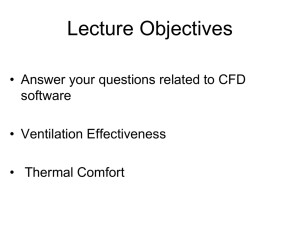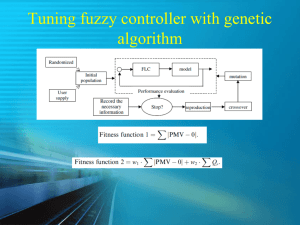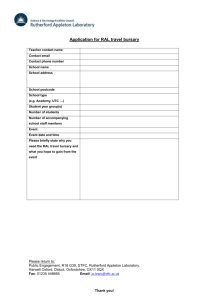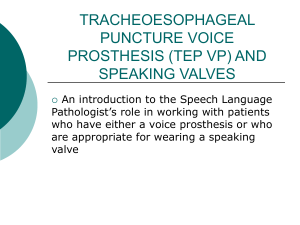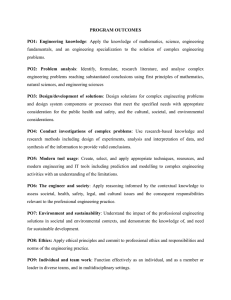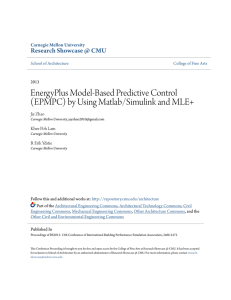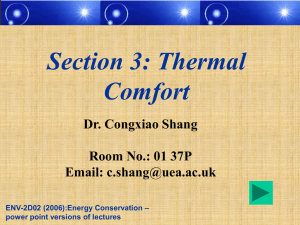A Computer-Aided Modeling and Measurement System for
advertisement
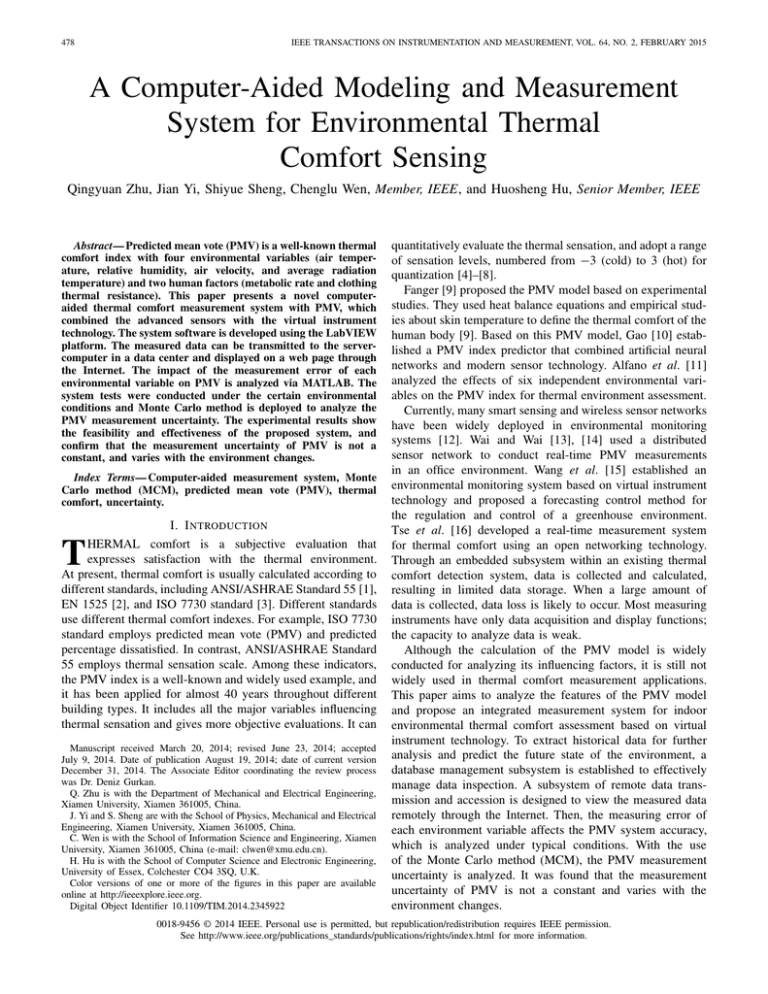
478
IEEE TRANSACTIONS ON INSTRUMENTATION AND MEASUREMENT, VOL. 64, NO. 2, FEBRUARY 2015
A Computer-Aided Modeling and Measurement
System for Environmental Thermal
Comfort Sensing
Qingyuan Zhu, Jian Yi, Shiyue Sheng, Chenglu Wen, Member, IEEE, and Huosheng Hu, Senior Member, IEEE
Abstract— Predicted mean vote (PMV) is a well-known thermal
comfort index with four environmental variables (air temperature, relative humidity, air velocity, and average radiation
temperature) and two human factors (metabolic rate and clothing
thermal resistance). This paper presents a novel computeraided thermal comfort measurement system with PMV, which
combined the advanced sensors with the virtual instrument
technology. The system software is developed using the LabVIEW
platform. The measured data can be transmitted to the servercomputer in a data center and displayed on a web page through
the Internet. The impact of the measurement error of each
environmental variable on PMV is analyzed via MATLAB. The
system tests were conducted under the certain environmental
conditions and Monte Carlo method is deployed to analyze the
PMV measurement uncertainty. The experimental results show
the feasibility and effectiveness of the proposed system, and
confirm that the measurement uncertainty of PMV is not a
constant, and varies with the environment changes.
Index Terms— Computer-aided measurement system, Monte
Carlo method (MCM), predicted mean vote (PMV), thermal
comfort, uncertainty.
I. I NTRODUCTION
T
HERMAL comfort is a subjective evaluation that
expresses satisfaction with the thermal environment.
At present, thermal comfort is usually calculated according to
different standards, including ANSI/ASHRAE Standard 55 [1],
EN 1525 [2], and ISO 7730 standard [3]. Different standards
use different thermal comfort indexes. For example, ISO 7730
standard employs predicted mean vote (PMV) and predicted
percentage dissatisfied. In contrast, ANSI/ASHRAE Standard
55 employs thermal sensation scale. Among these indicators,
the PMV index is a well-known and widely used example, and
it has been applied for almost 40 years throughout different
building types. It includes all the major variables influencing
thermal sensation and gives more objective evaluations. It can
Manuscript received March 20, 2014; revised June 23, 2014; accepted
July 9, 2014. Date of publication August 19, 2014; date of current version
December 31, 2014. The Associate Editor coordinating the review process
was Dr. Deniz Gurkan.
Q. Zhu is with the Department of Mechanical and Electrical Engineering,
Xiamen University, Xiamen 361005, China.
J. Yi and S. Sheng are with the School of Physics, Mechanical and Electrical
Engineering, Xiamen University, Xiamen 361005, China.
C. Wen is with the School of Information Science and Engineering, Xiamen
University, Xiamen 361005, China (e-mail: clwen@xmu.edu.cn).
H. Hu is with the School of Computer Science and Electronic Engineering,
University of Essex, Colchester CO4 3SQ, U.K.
Color versions of one or more of the figures in this paper are available
online at http://ieeexplore.ieee.org.
Digital Object Identifier 10.1109/TIM.2014.2345922
quantitatively evaluate the thermal sensation, and adopt a range
of sensation levels, numbered from −3 (cold) to 3 (hot) for
quantization [4]–[8].
Fanger [9] proposed the PMV model based on experimental
studies. They used heat balance equations and empirical studies about skin temperature to define the thermal comfort of the
human body [9]. Based on this PMV model, Gao [10] established a PMV index predictor that combined artificial neural
networks and modern sensor technology. Alfano et al. [11]
analyzed the effects of six independent environmental variables on the PMV index for thermal environment assessment.
Currently, many smart sensing and wireless sensor networks
have been widely deployed in environmental monitoring
systems [12]. Wai and Wai [13], [14] used a distributed
sensor network to conduct real-time PMV measurements
in an office environment. Wang et al. [15] established an
environmental monitoring system based on virtual instrument
technology and proposed a forecasting control method for
the regulation and control of a greenhouse environment.
Tse et al. [16] developed a real-time measurement system
for thermal comfort using an open networking technology.
Through an embedded subsystem within an existing thermal
comfort detection system, data is collected and calculated,
resulting in limited data storage. When a large amount of
data is collected, data loss is likely to occur. Most measuring
instruments have only data acquisition and display functions;
the capacity to analyze data is weak.
Although the calculation of the PMV model is widely
conducted for analyzing its influencing factors, it is still not
widely used in thermal comfort measurement applications.
This paper aims to analyze the features of the PMV model
and propose an integrated measurement system for indoor
environmental thermal comfort assessment based on virtual
instrument technology. To extract historical data for further
analysis and predict the future state of the environment, a
database management subsystem is established to effectively
manage data inspection. A subsystem of remote data transmission and accession is designed to view the measured data
remotely through the Internet. Then, the measuring error of
each environment variable affects the PMV system accuracy,
which is analyzed under typical conditions. With the use
of the Monte Carlo method (MCM), the PMV measurement
uncertainty is analyzed. It was found that the measurement
uncertainty of PMV is not a constant and varies with the
environment changes.
0018-9456 © 2014 IEEE. Personal use is permitted, but republication/redistribution requires IEEE permission.
See http://www.ieee.org/publications_standards/publications/rights/index.html for more information.
ZHU et al.: COMPUTER-AIDED MODELING AND MEASUREMENT SYSTEM
The rest of this paper is organized as follows. Section II
introduces the calculation theory of PMV. Section III describes
the system design, including system framework, hardware
configuration, and the modular software design that offers
flexibility and good scalability during the system operation.
Experimental results and a discussion are given in Section IV
to show the performance of the proposed system, including
the analysis of measurement uncertainty. Finally, a brief
conclusion and future work are given in Section V.
479
and η, are constants obtained from [3, Tables B.1 and C.1].
Then, PMV is calculated in an iterative process. The PMV
index establishes a quantitative expression about the rate of
body heat storage and the thermal sensation. The quantitative
expression represents the sensation of the majority of the
population under a same environment.
III. S YSTEM D ESIGN
A. System Framework
II. C ALCULATION T HEORY OF PMV
The PMV index is a prediction index that can be used
to predict thermal comfort by a PMV-based thermal comfort
model. The index integrates four environmental variables [air
temperature, relative humidity (RH), air velocity, and average
radiation temperature] and two human factors (metabolic rate
and clothing thermal resistance). Its mathematical expression
is expressed by the following equation [3], [9], [17]:
PMV = [0.303e−0.036M +0.0275]
×{M − W − 3.05[5.733 − 0.007(M − W ) − Pa ]
− 0.42(M − W − 58.15) − 1.73 × 10−2 M
× (5.867−Pa )−0.0014M
× [34 − ta − 3.96 × 10−8 × f cl |(tcl + 273)4
− (tr + 273)4| − f cl h c (tcl − ta )]}
(1)
where M is the metabolic rate (W/m2 ), W is the effective
mechanical power (W/m2 ), Pa is water vapor partial pressure
(KPa), f cl is the clothing surface area factor, tcl is the
clothing surface temperature (°C), tr is the mean radiant
temperature (°C), Icl is the clothing insulation (m2 · K/W),
ta is the air temperature (°C), and h c is the convective heat
transfer coefficient [W/(m2 · K)].
In (1), the water vapor partial pressure, Pa , and the effective
mechanical power, W , are calculated by
Pa = RH × exp[16.6536 − 4030.183/(ta + 235)]
(2)
W = ηM
(3)
where RH is measured in % and η is the effective utilization
coefficient of the mechanical work. The clothing surface area
factor, f cl , is determined as follows:
1.00 + 1.290Icl , Icl ≤ 0.078 m2 · K/W
f cl =
(4)
1.05 + 0.645Icl , Icl > 0.078 m2 · K/W.
The clothing surface temperature, tcl , is calculated by
tcl = 35.7 − 0.028(M − W ) − Icl {3.96 × 108 f cl
×[(tcl + 273)4 − (tr + 273)4 ] + f cl h c (tcl − ta )}. (5)
The convective heat transfer coefficient, h c , is determined
as follows:
2.38(tcl − ta )0.25 , 2.38(tcl − ta )0.25 > 12.1va0.5
(6)
hc =
12.1va0.5 ,
2.38(tcl − ta )0.25 < 12.1va0.5
where va is the air velocity (m/s).
The environment variables, ta , tr , va , and RH, are obtained
by the proposed measurement system. The parameters, M, Icl ,
Fig. 1 shows the whole system, which consists of the
PMV portable mobile measurement, remote data transmission, and accessing subsystems. First, the measurements of
air temperature, RH, air velocity, and black globe temperature are converted into a standard voltage or current signal
through signal conditioning and then sent into the integrated
acquisition instrument. The integrated acquisition instrument
wirelessly transmits the analogy signal to the computer-aided
PMV measurement system software for data acquisition, PMV
calculation, and further analysis.
Moreover, the data transmission subsystem transmits the
measured data to the server-computer from a monitoring
computer through the Internet. Then, a web page sited in a
server-computer is developed using PHP in order to display
the measured data. Client computers can visit the web page
and access data remotely over the Internet.
B. Hardware Configuration
The thermal comfort measurement system hardware mainly
consists of an acquisition instrument and a computer. The
acquisition instrument is divided into two layers: 1) the upper
layer consisting of the sensors and signal conditioning modules
and 2) the lower layer consisting of the data acquisition
modules and power supply. The computer functions as the
monitoring terminal. This configuration can reduce the temperature change caused by the heating of electronics and the
data acquisition module. Fig. 2 shows the physical hardware
configuration of our system.
To measure the indoor air temperature and RH, the temperature and humidity sensor is deployed, whose sensitivity is
12 °C/V and 20%/V, respectively. Its power supply is 24 V
dc and its output signal is in the range of 0–5 V. Similarly,
an air velocity sensor module is used to measure the indoor
air velocity, which has a 24 V dc voltage supply, an output
voltage signal of 0–10 V, and the sensitivity of 0.5 (m/s)/V.
Radiant temperature is related to the amount of radiant heat
transferred from a surface. It depends on the material’s ability
to absorb or emit heat, namely emissivity. The mean radiant
temperature experienced by a person in a room with sunlight
streaming in is based on how much of his or her body is
under the sunlight. Thus, the mean radiant temperature can be
replaced with the black globe temperature [17]. The black ball
temperature sensor consists of a black ball and an integrated
temperature transmitter, and the sensor probe is located in the
center of the black ball. The sensitivity of the black ball is
15 °C/V with a 24 V dc voltage supply and a module output
voltage signal of 1–5 V.
480
IEEE TRANSACTIONS ON INSTRUMENTATION AND MEASUREMENT, VOL. 64, NO. 2, FEBRUARY 2015
Fig. 1. System framework of the proposed system. The architecture consists of three main parts such as PMV portable mobile measurement, remote data
transmission, and accessing system.
Fig. 2.
Hardware configuration of the PMV portable mobile measurement subsystem.
A wireless measurement suite with 32 analog input channels
is used to transmit the collected data to the computer via
Wi-Fi. The input analog signals are enhanced by a shared
programmable instrumentation amplifier and then fed into an
A/D converter. The whole system shares a common-mode
voltage and a common-mode noise rejection capability so that
the quality of the measurement can be effectively improved.
Table I presents the details of the sensors and data acquisition
device discussed above.
C. Software Design
The computer-aided PMV measurement system software
is developed using LabVIEW, which has a parameter setting
ZHU et al.: COMPUTER-AIDED MODELING AND MEASUREMENT SYSTEM
481
TABLE I
S ENSORS AND D ATA A CQUISITION D EVICE L IST U SED IN THE S YSTEM
Fig. 3.
Flow chart of the measurement system.
Fig. 4.
module, a thermal comfort module, an air quality module, a
residential properties module, an emergency stopping module,
a historical data querying module, and a system setting
module. Fig. 3 shows its main program flowchart.
By means of a parameter setting module, the user can input:
1) the test location, construction parameters (e.g., area, number
of windows/doors, occupancy, and so forth), and measurement
starting and ending times and 2) the PMV parameter selection
and setting.
In the thermal comfort module, the following curves are
shown in the measurement interface in real time: 1) air
temperature; 2) RH; 3) indoor air velocity; 4) black ball
temperature; and 5) PMV. The highest, average, and lowest
values of each curve in the interface are updated at a fixed
interval. If the testing data exceeds the upper or lower limits
set by the user, the system will give an alarm.
If an emergency occurs, the emergency stopping module
will halt the measurement and return to the main interface.
In addition, this program measures not only PMV, but also
the air quality and residential properties as demanded.
D. Remote Data Transmission
In this system, data transmission between the monitoring
terminal and the server-computer is realized based on the
Internet. The network communication is realized via the
Socket interface, as well as the application programming
interface (API) and the Internet protocol suite (TCP/IP
protocol suite). In our system, a LabVIEW function based on
PHP language calls the API of Windows Sockets to achieve
Flow chart for remote data transmission.
network communication. The underlying network protocol
and operating system function is used by Windows Sockets
for actual communications.
On the server-side, we developed the web page for data
receiving using PHP language. The measured data is received
through the socket communication interface. The mobile
terminal or other client-computers can remotely view and
monitor the field measured PMV data by accessing the system
web page.
Fig. 4 shows the program flowchart for remote data transmission. The data acquiring program on the server-side is the
web application developed using PHP language. This program
binds the IP address and the port number through a bind
function and then monitors the port if there is a connection
request by activating the listen function. The LabVIEW-based
measurement system software simplifies the communication
with the Internet via the optimization and management of
TCP/IP. The field measurement data can be broadcasted to
the remote terminal through the computer network without
complex underlying TCP programming. In this paper, a TCP
node module is used to establish a connection to the Socket
interface on the server-side and sends data packets by an IP
address and server port number.
IV. E XPERIMENTS AND D ISCUSSION
A. PMV Calculation Process Verification
To verify the correctness of the PMV values calculated
by (1) in our system, we chose six groups of input variables
482
IEEE TRANSACTIONS ON INSTRUMENTATION AND MEASUREMENT, VOL. 64, NO. 2, FEBRUARY 2015
TABLE II
R ESULTS FOR THE S IX S ETS OF T ESTING I NPUTS
TO THE
N EW S ENSING S YSTEM
2) The change of tr in rows 3, 5, 6, and 7, as well as the
change of va in rows 3, 11, 12, and 13 results in the
change of the values of ∂PMV/∂ta , ∂PMV/∂tr , and
∂PMV/∂va .
3) The changes of RH in rows 8, 9, and 10 affect the
calculation of ∂PMV/∂ta .
The measurement error of the four environmental variables
primarily comes from the sensor error and the quantization
error of the A/D signal conversion. As shown in (8), T is
the measurement error of the environmental variable; T1 is
the sensor error; n is the conversion resolution of A/D [18].
In our system, n = 16, resulting in T ≈ T1 . Thus, the
quantization error of the A/D signal conversion is ignored in
the following analysis:
T = (1 + T1 )(1 + 1/2(n+1) )−1.
from [3, Table D.1] to calculate the PMV values by our
system. The differences between the example output from
[3, Table D.1] and the outputs from our system are shown
in Table II. It is clear that the difference in the PMV values
is small, i.e., varying between 0 and 0.01 for all six groups
of data. The results verify the effectiveness of the PMV
calculation in our system.
B. System Error Analysis
The PMV multivariate function expression is expressed as
PMV = f (ta , tr , RH, va ). According to [11], the system error
of PMV, written as PMV, is estimated as follows:
∂PMV ∂PMV ∂PMV RH
PMV ≈ ta + tr + ∂ta ∂tr ∂RH ∂PMV va .
(7)
+
∂va This equation indicates that PMV is influenced by the
environmental variables and their measurement errors. These
two kinds of influence are analyzed as follows.
1) Environmental Variables Influence on ΔPMV: To study
how each environmental variable influences the PMV system
error, 13 tests were conducted with different values of the
four environmental variables (ta , tr , RH, va ). The 13 sets of
environmental variable values and the first partial derivatives
are shown in Table III.
1) The change of ta in rows 1, 2, 3, and 4 results in the
changes of ∂PMV/∂ta , ∂PMV/∂tr , ∂PMV/∂RH, and
∂PMV/∂va . Thus, ta affects the values of ∂PMV/∂ta ,
∂PMV/∂tr , ∂PMV/∂RH, and ∂PMV/∂va .
(8)
The errors for each of the four variables in our system
(ta , tr , RH, va ) are ta = ±0.3 °C, t r = ±0.12 °C,
RH = ±3%, and va = ±0.04 m/s, respectively. As
shown in Fig. 5, PMV decreased linearly from 0.235 to
0.135 as air temperature (ta ) increased from 19 °C to 32 °C,
respectively. As shown in Fig. 6, PMV increased linearly
from 0.184 to 0.202 as the RH increased from 0% to 100%,
respectively.
Fig. 7 shows that PMV remains at ∼0.1 as the air
velocity increases from zero to <0.08 m/s. At an air velocity
equal to 0.08 m/s, PMV dramatically increases to 0.208.
As the air velocity increases from 0.08 to 0.4 m/s, PMV
decreases and asymptotically approaches to 0.15. It is clear
that PMV is affected by the air velocity in the range from
0.08 to 0.4 m/s.
2) Measurement Errors Influence ΔPMV: Different values
of PMV with different measurement errors in the environmental variables are shown in Table IV.
In the first row of Table IV, the measurement errors in
the environment variables are the required errors as listed in
[17, Table 2], and a PMV of 0.15 is calculated. In the second
row, the measurement errors of the environment variables are
about the sensors used in our system. PMV in these two
rows are close.
In each of the next four rows, three of the four measurement
errors are set to zero, and the other measurement error is calculated under the condition that PMV = 0.15. Because the
measurement error is always greater than zero, these four rows
of data indicate the minimum requirement of the measurement
errors for the four environmental sensors when PMV asymptotically approaches 0.15. Following the principle of equal
precision, the last row of data indicates the requirement for the
measurement errors of the four environmental sensors when
PMV asymptotically approaches 0.15.
C. System Test in an Indoor Environment
Before starting a measurement, a static calibration for each
sensor was carried out so that the displayed value of each
sensor is matched to the value measured by the precise
instrument under the same condition. Then, the proposed
ZHU et al.: COMPUTER-AIDED MODELING AND MEASUREMENT SYSTEM
483
TABLE III
R ESULTS OF PARTIAL D ERIVATIVE OF PMV TO E ACH E NVIRONMENTAL VARIABLE FOR 13 T YPICAL G ROUPS OF E NVIRONMENTAL
VARIABLE VALUES IN THE C ONDITION OF M = 58.15 W/m2 AND Icl = 1 CLO
Fig. 5. Curve of the relationship between system error of PMV and air
temperature in the condition of tr = ta , RH = 50%, va = 0.1 m/s,
M = 58.15 W/m 2 , and Icl = 1 clo.
Fig. 6. Curve of the relationship between system error of PMV and RH in
the condition of tr = ta = 24 °C, va = 0.1 m/s, M = 58.15 W/m 2 , and
Icl = 1 clo.
measurement system was tested under the following environmental conditions.
1) The indoor area was 50 m2 .
2) Four people were present.
3) The indoor area had four windows and a door.
Fig. 7. Curve of the relationship between system error of PMV and air
velocity in the condition of tr = ta = 24 °C, RH = 50%, M = 58.15 W/m 2 ,
and Icl = 1 clo.
The PMV-related measurement parameters were:
4) the PMV sampling rate of one point per second;
5) the activity of sit in and typical indoor clothing.
The following parameters were obtained from [3, Tables B.1
and C.1].
1) The human body metabolic rate is M = 58.15 W/m 2 .
2) The effective mechanical power is W = 0 W/m 2 .
3) The clothing insulation is Icl = 1 clo.
4) The clothing surface area factor is f cl = 1.15 by
calculation.
Under the above conditions, 72 points of data were obtained.
The four environmental variables, the calculated PMV, and
their distribution histograms are shown in Fig. 8.
D. Measurement Uncertainty Analyzing of PMV Using MCM
Guide to the expression of Uncertainty in Measurement
uncertainty framework is a common method used to evaluate
the measurement uncertainty in linear systems. It requires
approximation at each processing stage when the model is
484
IEEE TRANSACTIONS ON INSTRUMENTATION AND MEASUREMENT, VOL. 64, NO. 2, FEBRUARY 2015
TABLE IV
R ESULTS OF S YSTEM E RROR OF PMV W ITH D IFFERENT M EASUREMENT E RROR OF E ACH E NVIRONMENT VARIABLE IN THE
C ONDITION OF ta = 24 °C, tr = 24 °C, RH = 50%, va = 0.1 m/s, M = 58.15 W/m2 , AND Icl = 1 CLO
Fig. 9.
Fig. 8. Four environmental variables obtained from an indoor test and the
values of PMV calculated by our system. (a) Air temperature. (b) RH. (c) Air
velocity. (d) Black globe temperature. (e) PMV.
nonlinear. As a result, the validity of the results may be
unreliable. However, in this situation, MCM can generally
be expected to give valid results, since it does not make
approximation assumptions [19]. Thus, MCM is deployed in
this paper to calculate the uncertainty of PMV that has a
nonlinear model. Fig. 9 shows its detailed calculation process.
MCM is a numerical method used to assess the measurement uncertainty, which can simulate the spread of uncertainty
by repeated sampling [20]. Its application needs to establish
probability models as inputs, and then requires the simulating
calculation to determine a discrete expression of the output.
Detailed calculation process of MCM.
Finally, the characteristics of the output are estimated by
analyzing the discrete expression.
According to the shape of the distribution histograms in
Fig. 8, we assumed that the four PMV inputs are the normal
distribution and their standard deviations equal their combined
standard uncertainties, respectively. To simplify the uncertainty
model, the combined standard uncertainty only includes the
uncertainties caused by measurement repeatability and the
sensor inaccuracy.
The uncertainty caused by the measurement repeatability
(u 1 ) belongs to type A uncertainty, which is obtained by
i = x i − x̄
n 2
i=1 i
σ =
n−1
σ
u1 = √ .
n
(9)
(10)
(11)
ZHU et al.: COMPUTER-AIDED MODELING AND MEASUREMENT SYSTEM
485
TABLE V
T HREE K INDS OF U NCERTAINTIES AND A SSUMED D ISTRIBUTIONS
OF THE
F OUR E NVIRONMENT VARIABLES
TABLE VI
M EASUREMENT U NCERTAINTIES OF PMV
W ITH D IFFERENT S AMPLE S IZE
Fig. 10. Distribution histogram of PMV in the conditions of ta = 27.55 °C,
RH = 63.3%, va = 0.057 m/s, and tr = 29.84 °C. (a) PMV calculated with
72 points referred in Fig. 8. (b) PMV calculated with the use of MCM when
M = 2000.
TABLE VII
M EASUREMENT U NCERTAINTY OF PMV IN D IFFERENT
In the precision measurement, the width of the confidence
interval is usually set at 3σ . Thus, the uncertainties caused by
the measurement accuracy of sensors (u 2 ) belong to type B
uncertainty, which equals one third of the accuracy values
given by their specifications, respectively.
Both of the uncertainty components are independent; therefore, the combined standard uncertainty is obtained by the
following equation [21]:
(12)
u c = u 21 + u 22 .
Table V presents the three kinds of uncertainties and the
assumed distributions for the four environment variables.
As can be seen, four groups of random numbers were generated to function as the measurement errors of the four
environmental variables.
MCM requires a large number of sample data to estimate the
characteristics of the output. As long as the sample sizes are
large enough, the estimated result is accurate enough. In order
to choose a reasonable sample size, the PMV measurement
uncertainty is calculated with the same input when M = 1000,
2000, and 5000, respectively. Here, the input denotes the
average values of the four environmental variables, expressed
as ta , RH, va , tr , respectively.
Table VI shows the results that are calculated when the
input equals the average values (ta = 27.55 °C, RH = 63.3%,
va = 0.057 m/s, and tr = 29.84 °C) of the 72 points shown
in Fig. 8; then, M ≥ 2000, and the PMV measurement uncertainty is almost invariable. Therefore, to save computation
time, the sample size is set at 2000 in subsequent calculations.
Fig. 10 shows the distribution histogram of the output of
MCM under the conditions that ta = 27.55 °C, RH = 63.3%,
va = 0.057 m/s, and tr = 29.84 °C. MCM is used to computer
the PMV values and the average value of PMV is 1.536 under
E NVIRONMENTAL C ONDITIONS
these conditions. When the coverage probability P is 95%, the
coverage factor k p is 1.96. Hence, the expanded uncertainty
is u e = k p ∗ u = 0.035, and the PMV measuring result is
1.536 ± 0.035. Moreover, the PMV values in Fig. 10(a) fall
within this range.
Similar to the above process, the PMV measurement uncertainties are calculated under three different environmental
conditions and the results shown in Table VII. The PMV
measurement uncertainty is not a constant; it changes with
the change of environment values.
V. C ONCLUSION
This paper presents a new computer-aided thermal comfort
measurement system with PMV, which consists of five modules, namely multiparameter data acquisition, transmission,
calculation, display, and data management. The system was
tested under specific environmental conditions, and MCM
was used to analyze the PMV measurement uncertainty. How
the measurement error of each environmental variable affects
the PMV values was analyzed by MATLAB, which provides
a theoretical basis for selecting the measurement accuracy
of sensors. The PMV values calculated by our system are
compared with the PMV values obtained from the ISO 7730
standard [3]. The result shows the correctness of our computer
programs for PMV calculation. Moreover, the PMV measured
486
IEEE TRANSACTIONS ON INSTRUMENTATION AND MEASUREMENT, VOL. 64, NO. 2, FEBRUARY 2015
data can be transmitted to the server-side in a data center, and
can be remotely viewed through the Internet.
The main contribution of this paper is in proposing an integrated measurement system for indoor environmental thermal
comfort assessment based on virtual instrument technology.
The system has two key features: 1) powerful mathematical
analysis function for the complex calculation of PMV and
2) the modular software design that offers flexibility and good
scalability in system operation. Our future work will focus
on the evaluation of the system in the assessment of thermal
comfort.
ACKNOWLEDGMENT
This study was supported by NSFC grant (51205331) partially awarded to the corresponding author, Chenglu Wen.
[20] J. Wang, J. Guo, H. Wang, and Y. Deng, “The evaluation of measurement
uncertainty for laser tracker based on Monte Carlo method,” in Proc.
IEEE Int. Conf. Mechatronics Autom., Beijing, China, Aug. 2011,
pp. 608–612.
[21] L. Kirkup and R. B. Frenkel, An Introduction to Uncertainty in Measurement: Guide to the Expression of Uncertainty in Measurement.
New York, NY, USA: Cambridge Univ. Press, 2006.
Qingyuan Zhu received the bachelor’s degree in vehicle engineering in 2002,
and the Ph.D. degree in mechanical and electrical engineering from China
Agricultural University, Beijing, China, in 2009.
He was a Visiting Researcher with the School of Engineering, University of
Illinois at Urbana-Champaign, Champaign, IL, USA, in 2007. He is currently
an Assistant Professor with the Department of Mechanical and Electrical
Engineering, Xiamen University, Xiamen, China. His current research interests
include vehicle dynamic simulation and modeling, robotics, and mechatronics.
R EFERENCES
[1] Thermal Environmental Conditions for Human Occupancy,
ANSI/ASHRAE Standard 55–2013, 2013.
[2] Indoor Environmental Input Parameters for Design and Assessment of
Energy Performance of Buildings Addressing Indoor Air Quality, Thermal Environment, Lighting and Acoustics, BS EN Standard 15251:2007,
2007.
[3] Ergonomics of the Thermal Environment—Analytical Determination
and Interpretation of Thermal Comfort Using Calculation of the
PMV and PPD Indices and Local Thermal Comfort Criteria,
BS EN Standard ISO 7730:2005, 2005.
[4] S. P. Corgnati, M. Filippi, and S. Viazzo, “Perception of the thermal environment in high school and university classrooms: Subjective
preferences and thermal comfort,” Building Environ., vol. 42, no. 2,
pp. 951–959, 2007.
[5] N. H. Wong and S. S. Khoo, “Thermal comfort in classrooms in the
tropics,” Energy Buildings, vol. 35, no. 4, pp. 337–351, 2003.
[6] A. Pourshaghaghy and M. Omidvari, “Examination of thermal comfort
in a hospital using PMV–PPD model,” Appl. Ergomomics, vol. 43, no. 6,
pp. 1089–1095, 2012.
[7] S. Atthajariyakul and T. Leephakpreeda, “Real-time determination of
optimal indoor-air condition for thermal comfort, air quality and efficient
energy usage,” Energy Buildings, vol. 36, no. 7, pp. 720–733, 2004.
[8] R. Z. Homod, K. S. M. Sahari, H. A. F. Almurib, and F. H. Nagi, “RLF
and TS fuzzy model identification of indoor thermal comfort based on
PMV/PPD,” Building Environ., vol. 49, pp. 141–153, Mar. 2012.
[9] P. O. Fanger, Thermal Comfort: Analysis and Applications in Environmental Engineering. Copenhagen, Denmark: Technical Press, 1970.
[10] L. X. Gao, “Research on the intelligent predictor of indoor thermal
comfort,” Comput. Meas. Control, vol. 10, no. 8, pp. 519–520, 2002.
[11] F. R. d’Ambrosio Alfano, B. I. Palella, and G. Riccio, “The role of
measurement accuracy on the thermal environment assessment by means
of PMV index,” Building Environ., vol. 46, no. 7, pp. 1361–1369, 2011.
[12] D. De Donno, L. Catarinucci, and L. Tarricone, “RAMSES: RFID
augmented module for smart environmental sensing,” IEEE Trans.
Instrum. Meas., vol. 63, no. 7, pp. 1701–1708, Jul. 2014.
[13] W. L. Tse and W. L. Chan, “A distributed sensor network for measurement of human thermal comfort feelings,” Sens. Actuators A, Phys.,
vol. 144, no. 2, pp. 349–402, 2008.
[14] W. L. Tse and W. L. Chan, “Real-time measurement of thermal comfort
by using an open networking technology,” Measurement, vol. 40, no. 6,
pp. 654–664, 2007.
[15] L. B. Wang, Z. Y. Ge, and X. Y. Kong, “Greenhouse monitoring system
based on virtual instrument technology,” M.S. thesis, Dept. Biosyst.
Energy Eng., Kunming Univ. Science Technology, Yunnan, China, 2010.
[16] W. L. Tse, A. T. P. So, W. L. Chan, and I. K. Y. Mak, “The validity
of predicted mean vote for air-conditioned offices,” Facilities, vol. 23,
nos. 13–14, pp. 558–569, 2005.
[17] Ergonomics of the Thermal Environment—Instruments for Measuring
Physical Quantities, BS EN ISO Standard 7726:2001, 2001.
[18] M. J. Ma, Data Acquisition and Processing Technology, 3rd ed. Xi’an,
China: Xi’an Jiaotong Univ. Press, 2012.
[19] Evaluation of Measurement Data—Supplement 1 to the ‘Guide to the
Expression of Uncertainty in Measurement’—Propagation of Distributions Using a Monte Carlo Method, JCGM Standard 101:2008 2008.
Jian Yi received the B.Sc. degree from the Department of Mechanical Engineering, Xiamen University, Xiamen, China, in 2013, where he is currently
pursuing the Degree with the School of Physics and Mechanical and Electrical
Engineering.
His current research interests include vehicle dynamic simulation and
modeling.
Shiyue Sheng received the B.Sc. degree from the Department of Mechanical
Engineering, Xiamen University, Xiamen, China, in 2011, where he is
currently pursuing the Degree with the School of Physics and Mechanical
and Electrical Engineering.
His current research interests include vehicle dynamic simulation and
modeling.
Chenglu Wen (M’13) received the B.Sc. degree in mechanical automation
in 2003, and the Ph.D. degree in mechanical and electrical engineering from
China Agricultural University, Beijing, China, in 2009.
She was a Visiting Researcher with the School of Engineering, Michigan
State University, East Lansing, MI, USA, from 2007 to 2009. She is currently
an Assistant Professor with the School of Information Science and Engineering, Xiamen University, Xiamen, China. Her current research interests include
intelligent robots, machine vision, and learning algorithms.
Huosheng Hu (M’94–SM’01) received the M.Sc. degree in industrial automation from Central South University, Changsha, China, in 1982, and the Ph.D.
degree in robotics from the University of Oxford, Oxford, U.K., in 1993.
He is currently a Professor with the School of Computer Science and
Electronic Engineering, University of Essex, Colchester, U.K., where he is
leading the Robotics Research Group. He has authored over 420 papers. His
current research interests include robotics, human–robot interaction, embedded
systems, mechatronics, and pervasive computing.
Prof. Hu is a Founding Member of the IEEE Robotics and Automation
Society Technical Committee on Networked Robots, a fellow of the Institution
of Engineering and Technology and the Institute of Measurement Control, and
a Senior Member of the Association for Computing Machinery. He has been
the Program Chair and a member of the Advisory/Organizing Committee for
many international conferences, such as the IEEE International Conference on
Robotics and Automation, the IEEE International Conference on Intelligent
Robots and Systems, the IEEE International Conference on Mechatronics and
Automation, the IEEE International Conference on Robotics and Biomimetics,
and the IEEE International Conference on Information and Automation.
He currently serves as an Editor-in-Chief of the International Journal of
Automation and Computing and the online Robotics journal, and an Executive
Editor of the International Journal of Mechatronics and Automation.

